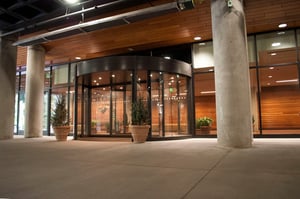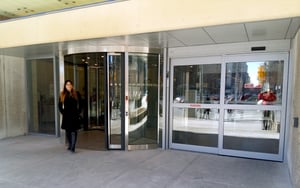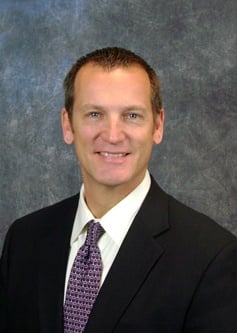Many of us have experienced the wind tunnel effect while entering a building. You confidently walk up to the front swing doors, pull on the handle and… nothing. The door feels like it’s glued shut. Or, as you walk through the ground level of a building, a large gust of wind catches you off guard and threatens to knock you off your feet. Then there’s also the chill that a strong, cold wind brings into an otherwise warm and comfortable building lobby.
What Exactly Causes the Wind Tunnel Effect?
So, what exactly is the wind tunnel effect and why does it happen? To answer these questions, we must understand how air moves. Generally speaking, air flows in and out of a building because of differences in air pressure:
- In winter, heated air rises to the top of a building (the “chimney effect”). When a door opens at the ground floor, cold air rushes inside the building to replace the warm air.
- In summer, the opposite happens. When the front doors open, conditioned air inside the building quickly rushes out to the street.
This quick exchange of air causes the wind tunnel effect, also known as “stack pressure.” And, the taller the building, the worse the problem is. This is such a big issue that the American Society of Civil Engineers (ASCE) has penned a document outlining minimum requirements for testing to determine wind loads on buildings and other structures.
How Do Revolving Doors Counteract the Wind Tunnel Effect?
To cut down on the wind tunnel effect inside buildings, architects are moving away from traditional sliding and swinging doors and installing manual and automatic revolving doors at the entrance. How do revolving doors work to counteract the wind tunnel effect?
Revolving doors operate under the principle of “always open, always closed.” As a result, there is less air exchange between the indoors and outdoors. This short video clip explains this principle well:
Beyond their ability to mitigate the wind tunnel effect, revolving doors also provide a number of other benefits, including:
- Reduction of energy costs by keeping conditioned air inside
- Capitalization of valuable floor space by eliminating the need for a double door vestibule
- Negligible invasion of down on dirt and debris, outside noises and fumes
Resort and Hospital Case Studies
The Cliff Lodge and Spa
The staf f and guests at The Cliff Lodge and Spa in Utah felt the massive impact of the wind tunnel effect during the winter months in the atrium of the 9-story building. Director of Village Operations at The Cliff, Jerry Giles, explained, “It was like standing in a windstorm. With outside temperatures as low as 20 degrees below zero, the atrium was really, really cold.”
f and guests at The Cliff Lodge and Spa in Utah felt the massive impact of the wind tunnel effect during the winter months in the atrium of the 9-story building. Director of Village Operations at The Cliff, Jerry Giles, explained, “It was like standing in a windstorm. With outside temperatures as low as 20 degrees below zero, the atrium was really, really cold.”
To address this issue, the resort replaced its double set of sliding doors with a large, 16-foot diameter revolving door. And both staff and guests felt an immediate difference. “Our new rotating door has solved at least 80% of the air flow issue and we can keep the space much more comfortable – it’s very different from before,” relates Giles.
Mt. Sinai Hospital
 Mt. Sinai Hospital in Toronto, Ontario also suffered from the effects of the wind tunnel effect firsthand. During the cold winter months, patients and visitors had to endure freezing wind tunnel conditions. The issue was so severe that employees using a smaller, employee-designated swinging entrance at times could not manually open that door.
Mt. Sinai Hospital in Toronto, Ontario also suffered from the effects of the wind tunnel effect firsthand. During the cold winter months, patients and visitors had to endure freezing wind tunnel conditions. The issue was so severe that employees using a smaller, employee-designated swinging entrance at times could not manually open that door.
Again, Mt. Sinai patients and staff saw an immediate change after the installation of two revolving doors – one at the main entrance and another at the employee-designated entrance. “The revolving doors are the best solution, given our space and property limitations, and these entrances have cut our wind tunnel effect by 60-70%,” said Tony Khouri, Vice President of Facilities and Capital Development and Mt. Sinai.
To learn more about how revolving doors help to mitigate the wind tunnel effect, please contact one of our entry experts.

